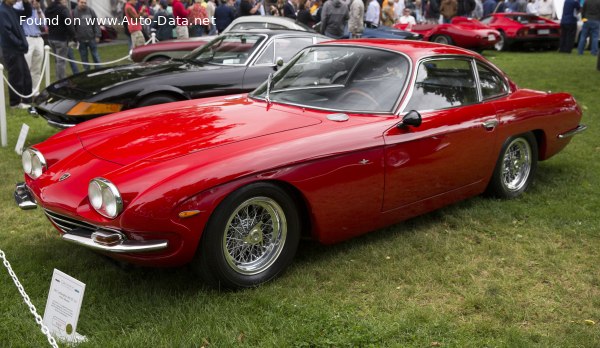




| What is the body type, Lamborghini 400 GT 2+2? | Coupe, 2 Doors, 4 Seats |
|---|---|
| What is the fuel economy, Lamborghini 400 GT 2+2 3.9 V12 (320 Hp)? | 16-18 l/100 km 14.7 - 13.1 US mpg 17.7 - 15.7 UK mpg 6.3 - 5.6 km/l |
| How fast is the car, 1965 400 GT 2+2 3.9 V12 (320 Hp)? | 270 km/h | 167.77 mph 0-100 km/h: 6.2 sec 0-60 mph: 5.9 sec |
| How much power, Lamborghini 400 GT Coupe 1965 3.9 V12 (320 Hp)? | 320 Hp, 374 Nm 275.85 lb.-ft. |
| What is the engine size, Lamborghini 400 GT Coupe 1965 3.9 V12 (320 Hp)? | 3.9 l 3929 cm3 239.76 cu. in. |
| How many cylinders, 1965 Lamborghini 3.9 V12 (320 Hp)? | 12, V-engine |
| What is the drivetrain, Lamborghini 400 GT 2+2 Coupe 1965 3.9 V12 (320 Hp)? | Rear wheel drive. Internal Combustion engine. The Internal combustion engine (ICE) drives the rear wheels of the vehicle. |
| How long is this vehicle, 1965 Lamborghini 400 GT Coupe? | 4460 mm 175.59 in. |
| How wide is the vehicle, 1965 Lamborghini 400 GT Coupe? | 1730 mm 68.11 in. |
| What is the curb weight, 1965 Lamborghini 400 GT 2+2 3.9 V12 (320 Hp)? | 1300 kg 2866.01 lbs. |
| What is the gross weight, 1965 Lamborghini 400 GT 2+2 3.9 V12 (320 Hp)? | 1670 kg 3681.72 lbs. |
| How much trunk (boot) space, 1965 Lamborghini 400 GT Coupe? | 330 l 11.65 cu. ft. |
| How many gears, What type is the gearbox, 1965 Lamborghini 400 GT 2+2 3.9 V12 (320 Hp)? | 5, manual transmission |
| General information | |
|---|---|
| Brand | Lamborghini |
| Model | 400 GT |
| Generation | 400 GT 2+2 |
| Modification (Engine) | 3.9 V12 (320 Hp) |
| Start of production | June, 1965 year |
| End of production | June, 1968 year |
| Powertrain Architecture | Internal Combustion engine |
| Body type | Coupe |
| Seats | 4 |
| Doors | 2 |
| Performance specs | |
| Fuel consumption (economy) - combined | 16-18 l/100 km
14.7 - 13.1 US mpg 17.7 - 15.7 UK mpg 6.3 - 5.6 km/l |
| Fuel Type | Petrol (Gasoline) |
| Acceleration 0 - 100 km/h | 6.2 sec |
| Acceleration 0 - 62 mph | 6.2 sec |
| Acceleration 0 - 60 mph (Calculated by Auto-Data.net) | 5.9 sec |
| Maximum speed | 270 km/h 167.77 mph |
| Weight-to-power ratio | 4.1 kg/Hp, 246.2 Hp/tonne |
| Weight-to-torque ratio | 3.5 kg/Nm, 287.7 Nm/tonne |
| Engine specs | |
| Power | 320 Hp @ 6500 rpm. |
| Power per litre | 81.4 Hp/l |
| Torque | 374 Nm @ 4500 rpm. 275.85 lb.-ft. @ 4500 rpm. |
| Engine layout | Front, Longitudinal |
| Engine displacement | 3929 cm3 239.76 cu. in. |
| Number of cylinders | 12 |
| Engine configuration | V-engine |
| Cylinder Bore | 82 mm 3.23 in. |
| Piston Stroke | 62 mm 2.44 in. |
| Compression ratio | 10.2:1 |
| Fuel injection system | Carburettor |
| Engine aspiration | Naturally aspirated engine |
| Valvetrain | DOHC |
| Space, Volume and weights | |
| Kerb Weight | 1300 kg 2866.01 lbs. |
| Max. weight | 1670 kg 3681.72 lbs. |
| Max load | 370 kg 815.71 lbs. |
| Trunk (boot) space - minimum | 330 l 11.65 cu. ft. |
| Fuel tank capacity | 87 l 22.98 US gal | 19.14 UK gal |
| Dimensions | |
| Length | 4460 mm 175.59 in. |
| Width | 1730 mm 68.11 in. |
| Height | 1285 mm 50.59 in. |
| Wheelbase | 2550 mm 100.39 in. |
| Front track | 1380 mm 54.33 in. |
| Rear (Back) track | 1380 mm 54.33 in. |
| Ride height (ground clearance) | 127 mm 5 in. |
| Minimum turning circle (turning diameter) | 11.5 m 37.73 ft. |
| Drivetrain, brakes and suspension specs | |
| Drivetrain Architecture | The Internal combustion engine (ICE) drives the rear wheels of the vehicle. |
| Drive wheel | Rear wheel drive |
| Number of gears and type of gearbox | 5 gears, manual transmission |
| Front suspension | Independent coil spring, Transverse stabilizer |
| Rear suspension | Independent coil spring, Transverse stabilizer |
| Front brakes | Disc |
| Rear brakes | Disc |
| Steering type | Worm-reduction unit |